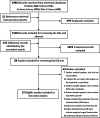The ROX index as a predictor of high-flow nasal cannula outcome in pneumonia patients with acute hypoxemic respiratory failure: a systematic review and meta-analysis
- PMID: 35365110
- PMCID: PMC8972647
- DOI: 10.1186/s12890-022-01914-2
The ROX index as a predictor of high-flow nasal cannula outcome in pneumonia patients with acute hypoxemic respiratory failure: a systematic review and meta-analysis
Abstract
Background: The respiratory rate-oxygenation (ROX) index has been increasingly applied to predict the outcome of high-flow nasal cannula (HFNC) in pneumonia patients with acute hypoxemic respiratory failure (AHRF). However, its diagnostic accuracy for the HFNC outcome has not yet been systematically assessed. This meta-analysis sought to evaluate the predictive performance of the ROC index for the successful weaning from HFNC in pneumonia patients with AHRF.
Methods: A literature search was conducted on electronic databases through February 12, 2022, to retrieve studies that investigated the diagnostic accuracy of the ROC index for the outcome of HFNC application in pneumonia patients with AHRF. The area under the hierarchical summary receiver operating characteristic curve (AUHSROC) was estimated as the primary measure of diagnostic accuracy due to the varied cutoff values of the index. We observed the distribution of the cutoff values and estimated the optimal threshold with corresponding 95% confidential interval (CI).
Results: Thirteen observational studies comprising 1751 patients were included, of whom 1003 (57.3%) successfully weaned from HFNC. The ROC index exhibits good performance for predicting the successful weaning from HFNC in pneumonia patients with AHRF, with an AUHSROC of 0.81 (95% CI 0.77-0.84), a pooled sensitivity of 0.71 (95% CI 0.64-0.78), and a pooled specificity of 0.78 (95% CI 0.70-0.84). The cutoff values of the ROX index were nearly conically symmetrically distributed; most data were centered between 4.5 and 6.0, and the mean and median values were 4.8 (95% CI 4.2-5.4) and 5.3 (95% CI 4.2-5.5), respectively. Moreover, the AUHSROC in the subgroup of measurement within 6 h after commencing HFNC was comparable to that in the subgroup of measurement during 6-12 h. The stratified analyses also suggested that the ROC index was a reliable predictor of HFNC success in pneumonia patients with coronavirus disease 2019.
Conclusions: In pneumonia patients with AHRF, the ROX index measured within 12 h after HFNC initiation is a good predictor of successful weaning from HFNC. The range of 4.2-5.4 may represent the optimal confidence interval for the prediction of HFNC outcome.
Keywords: Acute respiratory failure; High flow nasal cannula; Intubation; Pneumonia; ROX index.
© 2022. The Author(s).
Conflict of interest statement
The authors declare that they have no competing interests.
Figures




Similar articles
-
Respiratory rate‑oxygenation (ROX) index for predicting high-flow nasal cannula failure in patients with and without COVID-19.Am J Emerg Med. 2024 Jan;75:53-58. doi: 10.1016/j.ajem.2023.09.036. Epub 2023 Oct 14. Am J Emerg Med. 2024. PMID: 37913715
-
The value of ROX index in predicting the outcome of high flow nasal cannula: a systematic review and meta-analysis.Respir Res. 2022 Feb 17;23(1):33. doi: 10.1186/s12931-022-01951-9. Respir Res. 2022. PMID: 35177091 Free PMC article.
-
Performance of the ROX index in predicting high flow nasal cannula failure in COVID-19 patients: a systematic review and meta-analysis.Crit Care. 2023 Aug 21;27(1):320. doi: 10.1186/s13054-023-04567-7. Crit Care. 2023. PMID: 37605238 Free PMC article.
-
Expanding the utility of the ROX index among patients with acute hypoxemic respiratory failure.PLoS One. 2022 Apr 26;17(4):e0261234. doi: 10.1371/journal.pone.0261234. eCollection 2022. PLoS One. 2022. PMID: 35472205 Free PMC article.
-
Predicting success of high-flow nasal cannula in pneumonia patients with hypoxemic respiratory failure: The utility of the ROX index.J Crit Care. 2016 Oct;35:200-5. doi: 10.1016/j.jcrc.2016.05.022. Epub 2016 May 31. J Crit Care. 2016. PMID: 27481760
Cited by
-
Effectiveness of high-flow nasal cannula therapy on clinical outcomes in adults with COVID-19: A systematic review.Can J Respir Ther. 2023 Jan 20;59:52-65. doi: 10.29390/cjrt-2022-005. eCollection 2023. Can J Respir Ther. 2023. PMID: 36741308 Free PMC article. Review.
-
Highlights from the Respiratory Failure and Mechanical Ventilation Conference 2024.Breathe (Sheff). 2024 Nov 12;20(3):240105. doi: 10.1183/20734735.0105-2024. eCollection 2024 Oct. Breathe (Sheff). 2024. PMID: 39534488 Free PMC article.
-
High-Flow Nasal Cannula Application After Extubation in Acute Respiratory Failure Patients.J Clin Med. 2025 Apr 29;14(9):3087. doi: 10.3390/jcm14093087. J Clin Med. 2025. PMID: 40364118 Free PMC article.
-
Comparisons of mortality predictions of mROX, CURB-65, and APACHE II in patients with severe pneumonia: A retrospective cohort study.Medicine (Baltimore). 2025 Jun 13;104(24):e42931. doi: 10.1097/MD.0000000000042931. Medicine (Baltimore). 2025. PMID: 40527785 Free PMC article.
-
The ROX index: "Propelled" by high-flow nasal cannula therapy during the COVID-19 pandemic into greater applicability in respiratory support.Can J Respir Ther. 2022 Nov 17;58:182-184. doi: 10.29390/cjrt-2022-012. eCollection 2022. Can J Respir Ther. 2022. PMID: 36506639 Free PMC article. No abstract available.
References
-
- Rochwerg B, Granton D, Wang DX, Helviz Y, Einav S, Frat JP, et al. High flow nasal cannula compared with conventional oxygen therapy for acute hypoxemic respiratory failure: a systematic review and meta-analysis. Intensive Care Med. 2019;45(5):563–572. - PubMed
-
- Ni YN, Luo J, Yu H, Liu D, Ni Z, Cheng J, et al. Can high-flow nasal cannula reduce the rate of endotracheal intubation in adult patients with acute respiratory failure compared with conventional oxygen therapy and noninvasive positive pressure ventilation?: A systematic review and meta-analysis. Chest. 2017;151(4):764–775. doi: 10.1016/j.chest.2017.01.004. - DOI - PubMed
Publication types
MeSH terms
Grants and funding
LinkOut - more resources
Full Text Sources
Medical

